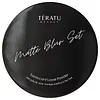What's inside
What's inside
 Key Ingredients
Key Ingredients

 Benefits
Benefits

 Concerns
Concerns

 Ingredients Side-by-side
Ingredients Side-by-side

Talc
AbrasiveNylon-12
Polymethylsilsesquioxane
Magnesium Myristate
Silica
AbrasiveBoron Nitride
AbsorbentPhenyl Trimethicone
Skin ConditioningDimethicone
EmollientCaprylyl Glycol
EmollientEthylhexylglycerin
Skin ConditioningTriethoxycaprylylsilane
CI 77492
Cosmetic ColorantCI 77491
Cosmetic ColorantCI 77499
Cosmetic ColorantTocopherol
AntioxidantNiacinamide
SmoothingWater
Skin ConditioningButylene Glycol
Humectant1,2-Hexanediol
Skin ConditioningCopper Tripeptide-1
Skin ConditioningAcetyl Hexapeptide-8
HumectantTalc, Nylon-12, Polymethylsilsesquioxane, Magnesium Myristate, Silica, Boron Nitride, Phenyl Trimethicone, Dimethicone, Caprylyl Glycol, Ethylhexylglycerin, Triethoxycaprylylsilane, CI 77492, CI 77491, CI 77499, Tocopherol, Niacinamide, Water, Butylene Glycol, 1,2-Hexanediol, Copper Tripeptide-1, Acetyl Hexapeptide-8
Talc
AbrasiveAluminum Starch Octenylsuccinate
AbsorbentMethyl Methacrylate Crosspolymer
Hydrated Silica
AbrasiveNylon-12
Diisostearyl Malate
EmollientIsononyl Isononanoate
EmollientSqualane
EmollientPhenoxyethanol
PreservativeCI 77891
Cosmetic ColorantSalicylic Acid
MaskingTocopheryl Acetate
AntioxidantGlycerin
HumectantCI 77492
Cosmetic ColorantButylene Glycol
HumectantEthylhexylglycerin
Skin ConditioningMelaleuca Alternifolia Leaf Oil
AntioxidantWater
Skin ConditioningCI 77491
Cosmetic ColorantCentella Asiatica Leaf Extract
Skin ConditioningRice Bran/Germ Triterpenoids
Skin ConditioningBioflavonoids
Skin ConditioningSesame Amino Acids
HumectantCI 77499
Cosmetic ColorantAluminum Hydroxide
EmollientHydrogen Dimethicone
Triethoxycaprylylsilane
Talc, Aluminum Starch Octenylsuccinate, Methyl Methacrylate Crosspolymer, Hydrated Silica, Nylon-12, Diisostearyl Malate, Isononyl Isononanoate, Squalane, Phenoxyethanol, CI 77891, Salicylic Acid, Tocopheryl Acetate, Glycerin, CI 77492, Butylene Glycol, Ethylhexylglycerin, Melaleuca Alternifolia Leaf Oil, Water, CI 77491, Centella Asiatica Leaf Extract, Rice Bran/Germ Triterpenoids, Bioflavonoids, Sesame Amino Acids, CI 77499, Aluminum Hydroxide, Hydrogen Dimethicone, Triethoxycaprylylsilane
Ingredients Explained
These ingredients are found in both products.
Ingredients higher up in an ingredient list are typically present in a larger amount.
Butylene Glycol (or BG) is used within cosmetic products for a few different reasons:
Overall, Butylene Glycol is a safe and well-rounded ingredient that works well with other ingredients.
Though this ingredient works well with most skin types, some people with sensitive skin may experience a reaction such as allergic rashes, closed comedones, or itchiness.
Learn more about Butylene GlycolCi 77491 is also hydrated iron III oxide. It's sole purpose is to give a red/pink hue to products.
Iron III oxides are classified as inorganic chemicals for coloring.
Synthetically created Ci 77491 is considered safer than those naturally found. This is because the synthetically created version may contain less impurities. Iron oxides are generally non-toxic and non-allergenic.
Learn more about CI 77491Ci 77492 is also hydrated iron III oxide. It's sole purpose is to give a yellow hue to products.
Iron III oxides are classified as inorganic chemicals for coloring.
Synthetically created Ci 77492 is considered safer than those naturally found. This is because the synthetically created version may contain less impurities. Iron oxides are generally non-toxic and non-allergenic.
Learn more about CI 77492Ci 77499 is also hydrated iron III oxide. It is created from mixing red and black iron oxides. This helps give shades of darkness to a product.
Iron III oxides are classified as inorganic chemicals for coloring.
Ethylhexylglycerin (we can't pronounce this either) is commonly used as a preservative and skin softener. It is derived from glyceryl.
You might see Ethylhexylglycerin often paired with other preservatives such as phenoxyethanol. Ethylhexylglycerin has been found to increase the effectiveness of these other preservatives.
Nylon-12 is a polymer. It is derived from 12-aminododecanoic acid, an omega-amino fatty acid
According to a manufacturer, it is a talc substitute. Like talc, nylon-12 gives products a satin feel. The manufacturer also claims this ingredients does not block pores and has moderate oil absorption.
This ingredient may not be reef-safe.
Learn more about Nylon-12Talc is a clay mineral. It helps absorb moisture and improve the texture of products. Like other types of clay, Talc can have a slight exfoliating effect on skin. Talc can be added to increase the volume of products.
Some Baby powders are made by combining talc with corn starch. The word "talc" comes from Latin and originates from Arabic. Talc is a mineral commonly found throughout the world.
If you have any concerns about using talc, we recommend checking out the FDA's official page.
Learn more about TalcTriethoxycaprylylsilane is a silicone used to bind and stabilize ingredients.
As an emulsifier, it helps prevent ingredients from separating. This can help elongate the shelf life of products.
Triethoxycaprylylsilane is often used to coat mineral sunscreens ingredients to help give a better feel. It also helps reduce oxidative stress in sunscreens.
Learn more about TriethoxycaprylylsilaneWater. It's the most common cosmetic ingredient of all. You'll usually see it at the top of ingredient lists, meaning that it makes up the largest part of the product.
So why is it so popular? Water most often acts as a solvent - this means that it helps dissolve other ingredients into the formulation.
You'll also recognize water as that liquid we all need to stay alive. If you see this, drink a glass of water. Stay hydrated!
Learn more about Water